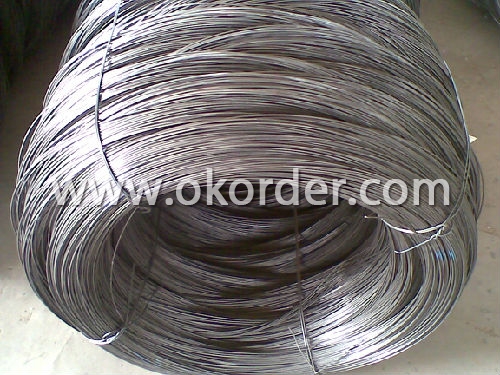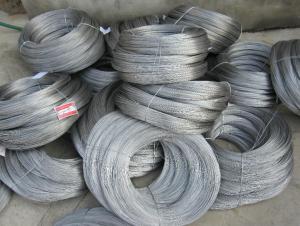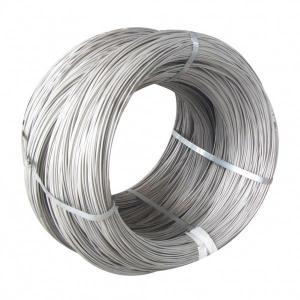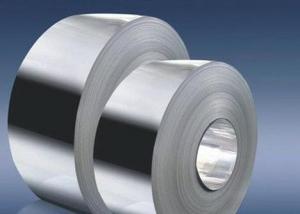304 Stainless Steel Wire
- Loading Port:
- China Main Port
- Payment Terms:
- TT or LC
- Min Order Qty:
- 1 Ton m.t.
- Supply Capability:
- 2000 Tons Per Month m.t./month
OKorder Service Pledge
OKorder Financial Service
You Might Also Like
304 Stainless Steel Wire
Application Of 304 Stainless Steel Wire
With bright surface, slight magnetism and no cracks on forming, is widely used in bicycle fittings, kitchen and sanitation tools, goods shelf, pet cages, gill racks, decorative handles and baskets, food and medical machinery accesses, etc.
Genral Information Of 304 Stainless Steel Wire
Grade | SS 200,300,400 series |
Dia | 0.1mm-100mm |
Length | 500m-2000m/Reel |
Surface | Bright |
Certificate | Fortune 500, SGS, ISO 9001:2008 |
Test | Salt Spray over200 hours |
Delivery | Within 20 days |
Packing | Reel, wooden box or according to your requirement |
Payment terms | China Main Port or CIF ANY PORT |
Application | Tie wire, pins, lashing, forming wire, filters, gaskets, elevators, safety wire, shaped and flat wire, conveyors, jewelry, springs, brush welding, electrical, wire line, craft and many more applications. |


- Q:What are the different types of stainless steel wire ropes used in mining?
- There are various types of stainless steel wire ropes used in mining, including 6x19 IWRC (Independent Wire Rope Core), 6x26 IWRC, and 8x19 Class Seale construction. These wire ropes are specifically designed to withstand the harsh conditions and heavy loads often encountered in mining operations.
- Q:What are the different types of stainless steel wire used in filtration applications?
- There are several types of stainless steel wire commonly used in filtration applications, including 304, 316, and 316L stainless steel. These grades of stainless steel offer excellent corrosion resistance, durability, and high tensile strength, making them suitable for various filtration processes. Additionally, they can withstand high temperatures and harsh environments, making them ideal for applications in industries such as oil and gas, food and beverage, pharmaceuticals, and water treatment.
- Q:What are the different wire gauges available for stainless steel wire?
- Different applications and requirements can be met with a variety of sizes for stainless steel wire gauges. The most commonly used wire gauges for stainless steel wire are usually measured in American Wire Gauge (AWG) or Standard Wire Gauge (SWG). In the United States, AWG is the most widely used measurement system, where the gauge number increases as the wire diameter decreases. AWG stainless steel wire gauges typically range from 10 to 38, with 10 being the thickest and 38 being the thinnest. These gauges find common use in electrical wiring, jewelry making, and industrial applications. On the other hand, SWG is a British measurement system also utilized in some parts of the world, including the United Kingdom. In SWG, as the gauge number increases, the wire diameter also increases. SWG stainless steel wire gauges range from 1 to 46, with 1 being the thickest and 46 being the thinnest. These gauges are commonly employed in various applications such as fencing, mesh manufacturing, and cable production. It is important to note that the specific stainless steel wire gauges available may vary depending on the supplier or manufacturer. To ensure the appropriate gauge selection for your specific needs, it is advisable to consult with the supplier or refer to standardized wire gauge charts.
- Q:Can stainless steel wire be used for outdoor applications?
- Yes, stainless steel wire can be used for outdoor applications. Stainless steel is highly resistant to corrosion and can withstand exposure to various weather conditions, making it a suitable material for outdoor use.
- Q:Can stainless steel wire be used for welding electrodes?
- Yes, stainless steel wire can be used for welding electrodes. It is commonly used in applications that require corrosion resistance and high strength, such as in the welding of stainless steel materials.
- Q:What are the different types of stainless steel wire springs for automotive applications?
- Automotive applications utilize various stainless steel wire springs, including compression springs, extension springs, torsion springs, and constant force springs. The most commonly utilized spring type in automotive applications is the compression spring. It is designed to resist compression and deliver a pushing or compressing force. Suspension systems, valve systems, and clutch systems often employ compression springs. In contrast, extension springs resist stretching or pulling forces. They find common usage in automotive applications like seat belts, door handles, and retractable antennas. Torsion springs exert twisting or rotational forces and are commonly found in trunk lids, hoods, and throttle systems. Constant force springs, a subtype of extension springs, offer a consistent force throughout their deflection range. They are frequently employed in automotive applications requiring a constant force, such as windshield wiper systems and automatic seatbelt retractors. These stainless steel wire springs are chosen for their durability, corrosion resistance, and ability to withstand high temperatures and harsh automotive environments. Moreover, the high strength-to-weight ratio of stainless steel wire springs ensures efficient and reliable performance in various automotive components.
- Q:Can stainless steel wire be used for making musical instrument strings?
- Yes, stainless steel wire can be used for making musical instrument strings. Stainless steel wire offers several advantages when used in musical instrument strings. Firstly, stainless steel is known for its durability and corrosion resistance, making it an ideal material for strings that are constantly exposed to moisture, sweat, and other environmental factors. This means that stainless steel strings have a longer lifespan and can withstand regular use without losing their tone or breaking easily. Additionally, stainless steel wire provides a bright and crisp tone, which is desirable for many musical instruments. The high-tensile strength of stainless steel allows for precise intonation and resonance, making it suitable for various instruments such as guitars, mandolins, banjos, and more. Moreover, stainless steel strings offer improved sustain and projection, enhancing the overall sound quality of the instrument. However, it's worth noting that the choice of string material depends on personal preference and the desired sound characteristics. Some musicians may prefer the warmth and mellower tone offered by other materials like nickel or bronze, while others may opt for the bright and more focused sound of stainless steel. Ultimately, the choice of string material should be based on the specific instrument, playing style, and the desired sound outcome.
- Q:How is stainless steel wire cleaned and maintained?
- Achieving effective cleanliness and maintenance for stainless steel wire can be accomplished by adhering to a few simple procedures. Initially, it is crucial to eliminate any surface dirt or debris by gently wiping the wire with a soft cloth or sponge that has been saturated in mild soap and warm water. This course of action will serve to prevent potential scratching or harm to the wire. In cases where stubborn stains or marks are present on the wire, the utilization of a non-abrasive cleaner specifically formulated for stainless steel is advisable. These cleaners are typically obtainable in liquid or spray form and should be applied to the wire in accordance with the instructions provided by the manufacturer. It is of utmost importance to avoid employing abrasive cleaners, bleach, or harsh chemicals, as these substances can inflict damage upon the surface of the stainless steel. Following the cleaning process, it is essential to thoroughly rinse the wire with clean water in order to eliminate any residual soap or cleaner. Proper drying procedures are vital to prevent the formation of water spots or corrosion, therefore it is recommended to employ a soft dry cloth to completely dry the wire. Should any moisture be allowed to remain on the surface, it has the potential to encourage the growth of rust or other forms of corrosion. In order to sustain the luster of the stainless steel wire and inhibit tarnishing, it is advisable to regularly apply a stainless steel polish or protectant. These products establish a protective barrier that aids in preventing fingerprints, smudges, and other blemishes from adhering to the wire. The polish can be administered through the use of a soft cloth, in accordance with the instructions provided by the manufacturer. In conjunction with regular cleaning and polishing procedures, it is imperative to avoid subjecting stainless steel wire to harsh environments or corrosive substances, as these can inflict damage upon the surface. If the wire is utilized in an outdoor setting, it is recommended to periodically inspect it for indications of corrosion or damage, and take appropriate measures to rectify any issues that may arise. By adhering to these practices for cleaning and maintenance, stainless steel wire can retain its excellent condition, preserving its durability, appearance, and functionality over an extended period of time.
- Q:What are the different types of stainless steel wire ropes used in marine applications?
- In marine applications, various stainless steel wire ropes are commonly employed due to their ability to endure the harsh conditions and corrosive environment of the marine industry. The following types are frequently utilized: 1. The 316 Stainless Steel Wire Rope is extensively employed in marine applications. It possesses remarkable corrosion resistance and can withstand exposure to saltwater and other corrosive elements. Moreover, it is renowned for its exceptional strength and durability. 2. The 304 Stainless Steel Wire Rope is also frequently utilized in marine applications. Although its corrosion resistance is not as high as the 316 stainless steel, it still offers good protection against corrosion. Additionally, it is recognized for its high tensile strength and resistance to abrasion. 3. The 316L Stainless Steel Wire Rope is a variation of the 316 stainless steel wire rope with lower carbon content. It provides similar corrosion resistance and strength properties as the 316 stainless steel. However, due to its reduced carbon content, it exhibits greater resistance to sensitization and intergranular corrosion. 4. The 7x19 Stainless Steel Wire Rope consists of 7 strands, with each strand containing 19 individual wires. This type of wire rope is known for its excellent flexibility and is commonly used in marine rigging, lifelines, and fishing nets that require high flexibility and corrosion resistance. 5. The 1x19 Stainless Steel Wire Rope consists of a single strand with 19 individual wires. It is recognized for its high tensile strength and is often utilized in standing rigging applications on sailboats, such as shrouds and stays. 6. The 7x7 Stainless Steel Wire Rope consists of 7 strands, with each strand containing 7 individual wires. It offers good flexibility and is commonly employed in applications that require moderate flexibility and corrosion resistance, such as guardrails and balustrades. 7. The 6x19 Stainless Steel Wire Rope consists of 6 strands, with each strand containing 19 individual wires. It strikes a balance between flexibility and strength and is frequently used in marine applications, including winches, cranes, and hoists. These examples represent just a few of the various types of stainless steel wire ropes utilized in marine applications. The selection of a specific wire rope type depends on the application's requirements, such as the desired level of corrosion resistance, strength, flexibility, and durability.
- Q:What are the different wire diameter measurement methods for stainless steel wire?
- Stainless steel wire can be measured using various methods to determine its diameter. These methods include: 1. Utilizing a micrometer: This tool, consisting of a calibrated screw and a scale, is commonly employed for precise wire diameter measurements. 2. Employing optical measurement: In this method, a microscope or digital camera captures an image of the wire, which is then analyzed using software to determine its diameter. 3. Adopting laser measurement: Laser measurement devices utilize laser beams to accurately measure the wire's diameter without any contact, making them ideal for measuring thin wires. 4. Employing wire gauges: Wire gauges are cylindrical tools with marked diameters. By passing the wire through the appropriate hole, the diameter can be determined based on the size of the hole it fits through. 5. Implementing wire drawing measurement: This method involves passing the wire through a series of progressively smaller dies to reduce its diameter. The size of the die used can then be used to ascertain the wire's diameter. Each method possesses its own set of advantages and limitations. Factors such as wire thickness, required accuracy, and equipment availability should be considered when selecting the most suitable method to ensure precise and dependable measurements of stainless steel wire diameter.
1. Manufacturer Overview |
|
|---|---|
| Location | Hebei,China |
| Year Established | 2009 |
| Annual Output Value | Above US$1 million |
| Main Markets | Asia, Middle East,America |
| Company Certifications | CE, CCC, ISO90001 |
2. Manufacturer Certificates |
|
|---|---|
| a) Certification Name | |
| Range | |
| Reference | |
| Validity Period | |
3. Manufacturer Capability |
|
|---|---|
| a)Trade Capacity | |
| Nearest Port | Tianjin |
| Export Percentage | 0.3 |
| No.of Employees in Trade Department | 4 People |
| Language Spoken: | English;Chinese |
| b)Factory Information | |
| Factory Size: | Above 5,000 square meters |
| No. of Production Lines | 3 |
| Contract Manufacturing | OEM Service Offered;Design Service Offered |
| Product Price Range | Lower |
Send your message to us
304 Stainless Steel Wire
- Loading Port:
- China Main Port
- Payment Terms:
- TT or LC
- Min Order Qty:
- 1 Ton m.t.
- Supply Capability:
- 2000 Tons Per Month m.t./month
OKorder Service Pledge
OKorder Financial Service
Similar products
New products
Hot products
Hot Searches
Related keywords

























